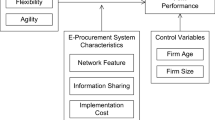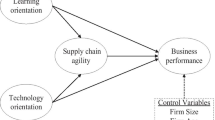Abstract
Drawing on the dynamic capability view, this study analyzes the effects of IT capabilities on supply chain capabilities and organizational agility. Based on survey data from 218 firms in Pakistan and employing structural equation modeling, our results reveal that the IT capabilities of IT infrastructure and IT assimilation influence supply chain capabilities of information integration and operational coordination, and that these supply chain capabilities affect organizational agility. In addition to the direct effects, IT infrastructure has an indirect effect on supply chain capabilities through IT assimilation, and information integration has an indirect effect on organizational agility through operational coordination. Theoretical and managerial implications are discussed.


Similar content being viewed by others

Change history
12 October 2020
The original version of this article unfortunately contained a mistake. One of the affiliations of the first author was missing.
References
Angeles R, Nath R (2011) Partner congruence in electronic data interchange (EDI)-enabled relationships. J Bus Logist 22(2):109–127
Babin BJ, Griffin M, Hair JF (2016) Heresies and sacred cows in scholarly marketing publications. J Bus Res 69:3133–3138
Barreto I (2010) Dynamic capabilities: a review of past research and an agenda for the future. J Manag 36(1):256–280
Bhattacharya M, Chu CH, Hayya J, Mullen T (2010) An exploratory study of RFID adoption in the retail sector. Oper Manag Res 3(1–2):80–89
Billah UI (2013) Cost minimization techniques: a case of dairy product manufacturers in Pakistan. Inform Manage & Bus Rev 5(1):28
Bharadwaj AS (2000) A resource-based perspective on information technology capability and firm performance: an empirical investigation. MIS Quarterly 24(1):169
Braunscheidel MJ, Suresh NC (2009) The organizational antecedents of a firm’s supply chain agility for risk mitigation and response. J Oper Manag 27(2):119–140
Brusset X, Teller C (2017) Supply chain capabilities, risks, and resilience. Int J Prod Econ 184:59–68
Bruque-Cámara S, Moyano-Fuentes J, Maqueira-Marín JM (2016) Supply chain integration through community cloud: effects on operational performance. J Purch Supply Manag 22(2):141–153
Cadden T, Downes SJ (2013) Developing a business process for product development. Bus Process Manag J 19(4):715–736
Cao M, Zhang Q (2011) Supply chain collaboration: impact on collaborative advantage and firm performance. J Oper Manag 29(3):163–180
Cao M, Zhang Q (2012) Supply chain collaboration: roles of inter-organizational systems, trust, and collaborative culture. Springer Science & Business Media
Cepeda G, Vera D (2007) Dynamic capabilities and operational capabilities: a knowledge management perspective. J Bus Res 60(5):426–437
Chae BK, Yang C, Olson D, Sheu C (2014) The impact of advanced analytics and data accuracy on operational performance: a contingent resource-based theory (RBT) perspective. Decis Support Syst 59:119–126
Chang, K., Kettinger, W.J. and Zhang, C., (2009). Assimilation of Enterprise Systems: The Mediating Role of Information Integration of Information Impact. ICIS 2009 Proceedings, p90
Davenport, T.H., (2006). Competing on analytics. Harv Bus Rev 84(1), p.98
DeGroote SE, Marx TG (2013) The impact of IT on supply chain agility and firm performance: an empirical investigation. Int J Inf Manag 33(6):909–916
Demeter K, Szász L, Rácz BG (2016) The impact of subsidiaries’ internal and external integration on operational performance. Int J Prod Econ 182:73–85
Devaraj S, Krajewski L, Wei JC (2007) Impact of eBusiness technologies on operational performance: the role of production information integration in the supply chain. J Oper Manag 25(6):1199–1216
Diamantopoulos A, Siguaw JA (2006) Formative versus reflective indicators in organizational measure development: a comparison and empirical illustration. Br J Manag 17(4):263–282
Dong S, Xu SX, Zhu KX (2009) Research note—information technology in supply chains: the value of it-enabled resources under competition. Inf Syst Res 20(1):18–32
Droge C, Vickery SK, Jacobs MA (2012) Does supply chain integration mediate the relationships between product/process strategy and service performance? An empirical study. Int J Prod Econ 137(2):250–262
Dwaikat NY, Money AH, Beheshti HM, Salehi-Sangari E (2018) How does information sharing affect first-tier suppliers’ flexibility? Evidence from the automotive industry in Sweden. Prod Plan Control 29(4):289–300
Eckstein D, Goellner M, Blome C, Henke M (2015) The performance impact of supply chain agility and supply chain adaptability: the moderating effect of product complexity. Int J Prod Res 53(10):3028–3046
Fainshmidt S, Pezeshkan A, Lance Frazier M, Nair A, Markowski E (2016) Dynamic capabilities and organizational performance: a meta-analytic evaluation and extension. J Manag Stud 53(8):1348–1380
Fawcett SE, Wallin C, Allred C, Fawcett AM, Magnan GM (2011) Information technology as an enabler of supply chain collaboration: a dynamic-capabilities perspective. J Supply Chain Manag 47(1):38–59
Flynn BB, Huo B, Zhao X (2010) The impact of supply chain integration on performance: a contingency and configuration approach. J Oper Manag 28(1):58–71
Fornell C, Larcker DF (1981) Structural equation models with unobservable variables and measurement error: algebra and statistics. J Mark Res 18:382–388
Forslund H (2015) Performance management process integration in retail supply chains. Int J Retail Distrib Manag 43(7):652–670
Ghaemmaghami M, Hassanein K, Turel O (2017) Increasing firm agility through the use of data analytics: the role of fit. Decis Support Syst 101:95–105
Gligor MD, Holcomb M (2014) The road to supply chain agility: an RBV perspective on the role of logistics capabilities. Int J Logist Manag 25(1):160–179
Gligor DM, Holcomb MC, Feizabadi J (2016) An exploration of the strategic antecedents of firm supply chain agility: the role of a firm's orientations. Int J Prod Econ 179:24–34
Hair JF, Hult GTM, Ringle C, Sarstedt M (2016) A primer on partial least squares structural equation modeling (PLS-SEM). Thousand Oaks, CA: Sage Publication
Hardgrave BC, Goyal S, Aloysius JA (2011) Improving inventory management in the retail store: the effectiveness of RFID tagging across product categories. Oper Manag Res 4(1–2):6–13
Hayes AF, Scharkow M (2013) The relative trustworthiness of inferential tests of the indirect effect in statistical mediation analysis: does method matter? Psychol Sci 24(10):1918–1927
Helfat CE, Winter SG (2011) Untangling dynamic and operational capabilities: strategy for the (N) ever-changing world. Strateg Manag J 32(11):1243–1250
Huo B (2012) The impact of supply chain integration on company performance: an organizational capability perspective. Supply Chain Manag An Int J 17(6):596–610
Huo B, Qi Y, Wang Z, Zhao X (2014a) The impact of supply chain integration on firm performance: the moderating role of competitive strategy. Supply Chain Manag An Int J 19(4):369–384
Huo B, Zhao X, Zhou H (2014b) The effects of competitive environment on supply chain information sharing and performance: an empirical study in China. Prod Oper Manag 23(4):552–569
Huo B, Han Z, Chen H, Zhao X (2015) The effect of high-involvement human resource management practices on supply chain integration. Int J Phys Distrib Logist Manag 45(8):716–746
Huo B, Han Z, Prajogo D (2016) Antecedents and consequences of supply chain information integration: a resource-based view. Supply Chain Manag An Int J 21(6):661–677
Ismail HS, Sharifi H (2006) A balanced approach to building agile supply chains. Int J Phys Distrib Logist Manag 36(6):431–444. https://doi.org/10.1108/09600030610677384
Jonsson P, Holmström J (2016) Future of supply chain planning: closing the gaps between practice and promise. Int J Phys Distrib Logist Manag 46(1):62–81
Junqueira, R. V. (2010). Governance structure and supply chain management practices in the dairy value chain: a comparative study between New Zealand and Brazil: a thesis presented in partial fulfillment of the requirements for the degree of master of logistics and supply chain Management at Massey University, Auckland, New Zealand (Doctoral dissertation, Massey University)
Katunzi TM (2011) Obstacles to process integration along the supply chain: manufacturing firms perspective. Int J Bus Manag 6(5):105
Lee HL, Whang S (2004) E-business and supply chain integration. In The practice of supply chain management: Where theory and application converge (pp. 123–138). Springer, Boston
Leuschner R, Rogers DS, Charvet FF (2013) A meta-analysis of supply chain integration and firm performance. J Supply Chain Manag 49(2):34–57
Li S, Lin B (2006) Accessing information sharing and information quality in supply chain management. Decis Support Syst 42(3):1641–1656
Liang H, Saraf N, Hu Q, Xue Y (2007) Assimilation of enterprise systems: the effect of institutional pressures and the mediating role of top management. MIS Q 31:59–87
Liu H, Ke W, Wei KK, Hua Z (2013) The impact of IT capabilities on firm performance: the mediating roles of absorptive capacity and supply chain agility. Decis Support Syst 54(3):1452–1462
Liu H, Wei S, Ke W, Wei KK, Hua Z (2016) The configuration between supply chain integration and information technology competency: a resource orchestration perspective. J Oper Manag 44:13–29
Lotfi Z, Mukhtar M, Sahran S, Zadeh AT (2013) Information sharing in supply chain management. Procedia Technology 11:298–304
Lowry PB, Wilson D (2016) Creating agile organizations through IT: the influence of internal IT service perceptions on IT service quality and IT agility. J Strateg Inf Syst 25(3):211–226
Lu Y, Ramamurthy K(R) (2011) Understanding the link between information technology capability and organizational agility: an empirical examination. MIS Q 35:931–954
Mikalef P, Pateli A (2017) Information technology-enabled dynamic capabilities and their indirect effect on competitive performance: findings from PLS-SEM and fsQCA. J Bus Res 70:1–16
Mithas S, Ramasubbu N, Sambamurthy V (2008) Information management capability and firm performance: An empirical analysis. MIS Quarterly
Ngai E, Chau D, Chan T (2011) Information technology, operational, and management competencies for supply chain agility: findings from case studies. J Strateg Inf Syst 20(3):232–249
Oh LB, Teo HH, Sambamurthy V (2012) The effects of retail channel integration through the use of information technologies on firm performance. J Oper Manag 30(5):368–381
Oliva R, Watson N (2011) Cross-functional alignment in supply chain planning: a case study of sales and operations planning. J Oper Manag 29(5):434–448
Overby E, Bharadwaj A, Sambamurthy V (2006) Enterprise agility and the enabling role of information technology. Eur J Inf Syst 15(2):120–131
Paulraj A, Lado AA, Chen IJ (2008) Inter-organizational communication as a relational competency: antecedents and performance outcomes in collaborative buyer-supplier relationships. J Oper Manag 26(1):45–64
Peng DX, Schroeder RG, Shah R (2008) Linking routines to operations capabilities: a new perspective. J Oper Manag 26(6):730–748
Peteraf MA (1993) The cornerstones of competitive advantage: a resource-based view. Strateg Manag J 14(3):179–191
Prajogo D, Olhager J (2012) Supply chain integration and performance: the effects of long-term relationships, information technology, and sharing, and logistics integration. Int J Prod Econ 135(1):514–522
Prajogo D, Oke A, Olhager J (2016) Supply chain processes: linking supply logistics integration, supply performance, lean processes, and competitive performance. Int J Oper Prod Manag 36(2):220–238
Preacher KJ, Hayes AF (2008) Asymptotic and resampling strategies for assessing and comparing indirect effects in multiple mediator models. Behav Res Methods 40(3):879–891
Qi Y, Zhao X, Sheu C (2011) The impact of competitive strategy and supply chain strategy on business performance: the role of environmental uncertainty. Decis Sci 42(2):371–389
Qi Y, Huo B, Wang Z, Yeung HYJ (2017) The impact of operations and supply chain strategies on integration and performance. Int J Prod Econ 185:162–174
Qrunfleh S, Tarafdar M (2014) Supply chain information systems strategy: impacts on supply chain performance and firm performance. Int J Prod Econ 147:340–350
Radhakrishnan A, Davis JS, Sridharan SV, Moore DW, David D (2016) The impact of inter-organizational information systems-enabled external integration on capabilities of buyer–supplier dyads. Eur Manag J 36(4):558–572
Rai A, Tang X (2010) Leveraging IT capabilities and competitive process capabilities for the management of inter-organizational relationship portfolios. Inf Syst Res 21(3):516–542
Rai, A., Patnayakuni, R., & Seth, N. (2006). Firm performance impacts of digitally enabled supply chain integration capabilities. MIS quarterly, 225-246
Rajaguru R, Matanda MJ (2013) Effects of inter-organizational compatibility on supply chain capabilities: exploring the mediating role of inter-organizational information systems (IOIS) integration. Ind Mark Manag 42(4):620–632
Richey RG Jr, Roath AS, Whipple JM, Fawcett SE (2010) Exploring a governance theory of supply chain management: barriers and facilitators to integration. J Bus Logist 31(1):237–256
Saeed KA, Malhotra MK, Grover V (2005) Examining the impact of interorganizational systems on process efficiency and sourcing leverage in buyer-supplier dyads. Decis Sci 36(3):365–396
Sammuel, S. and Kashif, H., (2013). Levels and barriers to supply chain integration: a survey on Haleeb foods distributor's in Pakistan
Sanders, NR. (2014) Big data driven supply chain management: A framework for implementing analytics and turning information into intelligence. Pearson Education
Saraf N, Langdon CS, Gosain S (2007) IS application capabilities and relational value in interfirm partnerships. Inf Syst Res 18(3):320–339
Seo YJ, Dinwoodie J, Kwak DW (2014) The impact of innovativeness on supply chain performance: is supply chain integration a missing link? Supply Chain Manag An Int J 19(5/6):733–746
Soundararajan V, Brown JA (2016) Voluntary governance mechanisms in global supply chains: beyond CSR to a stakeholder utility perspective. J Bus Ethics 134(1):83–102
Swafford PM, Ghosh S, Murthy N (2006) The antecedents of supply chain agility of a firm: scale development and model testing. J Oper Manag 24:170–188
Swafford PM, Ghosh S, Murthy N (2008) Achieving supply chain agility through IT integration and flexibility. Int J Prod Econ 116(2):288–297
Tan KH, Zhan Y, Ji G, Ye F, Chang C (2015) Harvesting big data to enhance supply chain innovation capabilities: an analytic infrastructure based on the deduction graph. Int J Prod Econ 165:223–233
Teece DJ, Pisano G, Shuen A (1997) Dynamic capabilities and strategic management. Strateg Manag J 18(7):509–533
Tian J, Wang K, Chen Y, Johansson B (2010) From IT deployment capabilities to competitive advantage: an exploratory study in China. Inf Syst Front 12(3):239–255
Tiwari AK, Tiwari A, Samuel C (2015) Supply chain flexibility: a comprehensive review. Manag Res Rev 38(7):767–792
Vanpoucke E, Vereecke A, Muylle S (2017) Leveraging the impact of supply chain integration through information technology. Int J Oper Prod Manag 37(4):510–530
Wagner, S. M., Grosse-Ruyken, P. T. and Erhun, F. (2018) ‘Determinants of sourcing flexibility and its impact on performance’, International Journal of Production Economics. Elsevier B.V., 205, pp. 329–341
Waller MA, Fawcett SE (2013) Data science, predictive analytics, and big data: a revolution that will transform supply chain design and management. J Bus Logist 34(2):77–84
Willis G, Genchev SE, Chen H (2016) Supply chain learning, integration, and flexibility performance: an empirical study in India. Int J Logist Manag 27(3):755–769
Wong CY, Boon-Itt S, Wong CW (2011) The contingency effects of environmental uncertainty on the relationship between supply chain integration and operational performance. J Oper Manag 29(6):604–615
Wu LY (2010) Applicability of the resource-based and dynamic-capability views under environmental volatility. J Bus Res 63(1):27–31
Wu F, Yeniyurt S, Kim D, Cavusgil ST (2006) The impact of information technology on supply chain capabilities and firm performance: a resource-based view. Ind Mark Manag 35(4):493–504
Wu KJ, Tseng ML, Chiu AS, Lim MK (2017) Achieving competitive advantage through supply chain agility under uncertainty: a novel multi-criteria decision-making structure. Int J Prod Econ 190:96–107
Yang J (2014) Supply chain agility: securing performance for Chinese manufacturers. Int J Prod Econ 150:104–111
Ye F, Wang Z (2013) Effects of information technology alignment and information sharing on supply chain operational performance. Comput Ind Eng 65(3):370–377
Yu W, Chavez R, Jacobs MA, Feng M (2018) Data-driven supply chain capabilities and performance: a resource-based view. Transp Res PART E 114:371–385
Yusuf YY, Gunasekaran A, Adeleye EO, Sivayoganathan K (2004) Agile supply chain capabilities: determinants of competitive objectives. Eur J Oper Res 159(2):379–392
Zhao L, Huo B, Sun L, Zhao X (2013) The impact of supply chain risk on supply chain integration and company performance: a global investigation. Supply Chain Manag An Int J 18(2):115–131
Acknowledgements
This work was supported in part by the NSFC under Grants 71671023, in part by the Foundation for Innovative Research Groups of NSFC under Grant 71421001, the development Foundation of teaching and scientific research for teachers of Liberal Arts in Zhejiang University. We would like to thank the Editor-in-Chief, area editor and anonymous reviewers for their honest, helpful and constructive comments.
Author information
Authors and Affiliations
Corresponding author
Additional information
Publisher’s note
Springer Nature remains neutral with regard to jurisdictional claims in published maps and institutional affiliations.
APPENDIX
APPENDIX
Rights and permissions
About this article
Cite this article
Irfan, M., Wang, M. & Akhtar, N. Impact of IT capabilities on supply chain capabilities and organizational agility: a dynamic capability view. Oper Manag Res 12, 113–128 (2019). https://doi.org/10.1007/s12063-019-00142-y
Received:
Revised:
Accepted:
Published:
Issue Date:
DOI: https://doi.org/10.1007/s12063-019-00142-y



